You don’t need a handlebar mustache and a singlet to reap the benefits of the get-up. This exercise, popularized by old-time strongmen, has finally its way into mainstream fitness.
The get-up is like no other exercise—it’s a series of movements that seamlessly flow together. What other exercise takes you from the ground to standing in such a methodical fashion? Because of this, the get-up requires a great deal of coordination, mobility, motor control, and strength.
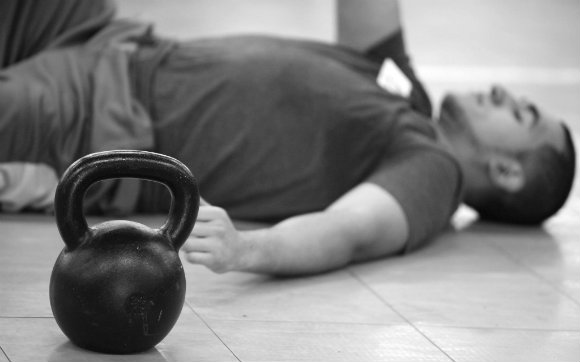
There is a story about the get-up and how old-time strongmen trained this exercise. If your goal was to become a performing strongman, having the ability to perform a 100-pound get-up was the starting point.
Think about that. A 100-pound get-up was basically a rite of passage, and just a point to begin your strength training journey. Clearly in that scenario the get-up was used as a strength exercise, but it can be trained in several different ways.
In this article, I’m going to show you how to incorporate the get-up into your programming with three different goals mind:
- Skill Development
- Strength
- Movement Prep
Goal: Skill Development
Once you’ve learned how to perform a get-up safely, and with adequate technique, it’s time to polish the chrome.
The first aspect of skill development is giving yourself adequate time to practice. If you are trying to master a movement, five minutes here or there is not going to cut it. I have found that dedicating a minimum of twenty minutes to a particular skill is a great starting point.
I’ve been teaching workshops and certifications for years and have taught hundreds of people the get-up. I’ve noticed that small reminders in each step help students understand the key points of each position.
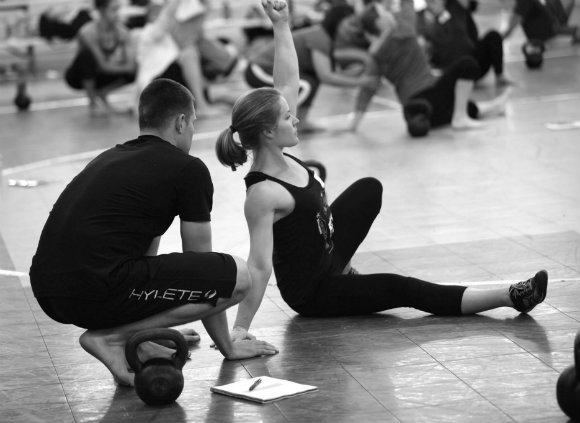
Below, I’ve listed three teaching points or reminders for each stage of the get-up. Once you can confidently check off these three key points, you can move onto the next step.
Roll to elbow:
- Did both shoulders stay packed?
- Was the roll up to the elbow smooth?
- Is my arm holding the bell vertical?
Elbow to post:
- Are both shoulders packed?
- Am I extending my thoracic spine?
- Are both elbows locked out?
Sweep:
- Did I maintain a neutral spine during the sweep?
- Did my knee land in an adequate position?
- Are both shoulders still packed?
Half kneel:
- Did I perform a hip hinge to get into the half kneel position?
- Is the bell overhead without any compensation?
- Am I in a strong half kneel position so I can stand with control?
Standing position:
- Do I have a level pelvis?
- Is the bell directly overhead with my bicep by my ear?
- Is the shoulder holding the bell packed?
Reverse lunge:
- Did I take a far enough step back?
- Do I have approximately ninety-degree angles in both knees?
- Did I maintain good alignment once I landed?
Windshield wiper:
- Did I rotate the bottom hip enough to avoid lateral lumbar flexion?
- Did I perform a hip hinge?
- Is my support hand on the floor close enough to my body?
Sit-through:
- Did the arm holding the bell stay vertical?
- Was I stable on both the foot and hand as I brought the leg through?
- Does this look like the post position from the earlier part of the get-up?
Reverse elbow to floor:
- Did I control the descent?
- Did my bottom shoulder shrug at all?
- Did the arm holding the bell stay vertical?
The above cues are an example and a starting point. Feel free to switch them out to the coaching points that work best for you and/or your students.
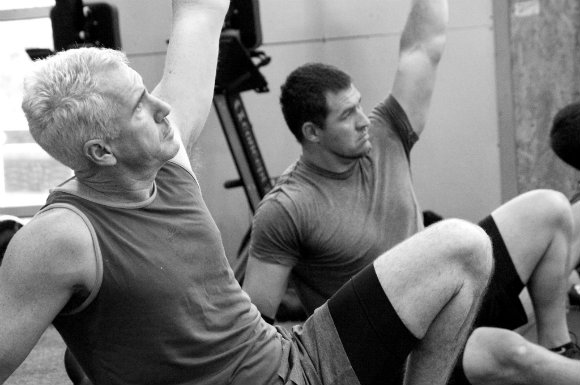
Obviously, these reminders will help you through your sticking points, but going through this checklist each time will also slow you down. So, when you are learning to get-up, take your time and always be deliberate with your practice.
Training the get-up in this fashion takes a bit longer so I suggest performing anywhere from three to five repetitions per side. If you are using a lighter bell, you can perform several repetitions on one side. If you are using a heavier bell, you may want to alternate sides.
Goal: Strength
A heavy get-up presents a challenge that is very different from traditional heavy lifting:
- The get-up is trained with a unilateral load, whereas traditional heavy lifts tend to be bilateral.
- The average time to complete one full repetition of a get-up tends to be between :25 and :40, whereas a single max effort deadlift takes between :04 to :06. The time under tension is very different in these two exercises.
- The total number or reps completed in a single session will be significantly lower than other compound lifts. Linear progressions are not optimal and making weekly jumps over the course of ten to twelve weeks can be tough due to the fact most kettlebell sizes increase by 4kg.
So what type of program should you use to achieve a heavy get-up? I recommend wavering the load with a three-day program based around a heavy day, a medium day, and a light day. Below are some basic set-and-rep schemes to consider when programming the get-up for strength training.
Medium Day:
- 5 get-ups per side (10 total), alternate sides
- Workload is approximately 75% of your 1RM
- Rest time is approximately 3-4 minutes in between sets
Light Day:
- 4 sets of 2 get-ups per side (16 total), perform two get-ups in a row on the same side to equal one set
- Workload is between 55 and 65% of your 1RM
- Rest time is between 2 to 3 minutes between sets
Heavy Day:
- 2-3 get-ups per side (4-6 total), alternate sides
- Workload is between 85 and 90% of your 1RM
- Rest time is between 4 and 5 minutes
The key is to understand your basic percentages and work from there. Some days will be lighter, others will be heavier—but stick to the basic percentages. When in doubt, rest longer. If you miss a rep, drop a bell size and complete the repetition clean.
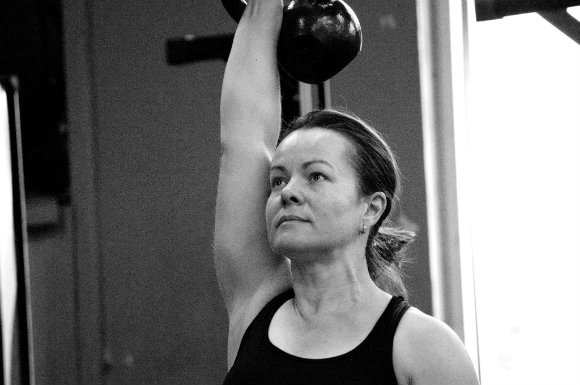
Goal: Movement Prep
The get-up can be a fantastic tool as part of your movement preparation. There are several ways to approach this, but my favorite plan is pretty simple:
- Grab a medium-sized bell and perform 10 minutes of alternating get-ups.
- Stay focused, keep the transitions smooth, and don’t waste time when switching sides.
Within these ten minutes, you can most likely perform anywhere from ten to twelve get-ups total. This seems like a fair amount of volume, but it’s incredibly effective and time efficient.
Don’t rush, and remember it’s not a race. We aren’t trying to see how many reps we can cram into ten minutes. The goal is to improve core temperature, increase blood flow, improve skill, and dedicate ten minutes to actually warming up.
Be Smart When You Program the Get-up
The get-up can be an incredibly useful training tool—depending on your goals and where you are at in your movement journey, it can be implemented differently.
But regardless of your goal, it’s always good to have a game plan. The above suggestions will get you started in the right direction. Remember, quality over quantity, train smart, and train hard!
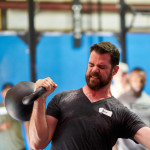
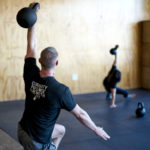
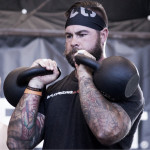






1RM deadlift?
Excellent article, and useful.
Thank you Eric!
Some gold in here for sure!
Very good article.
At what point would you recommend increasing the weight /where does the 1RM bell come into play?
Thanks for reading.
Hi s f-
As you get stronger- your light bells may slowly become medium sized bells and medium bells will eventually become your heavy ones. It’s a process and once you get acclimated with this plan, you will “feel” when you are ready to bump up. Here’s how I approach it:
Find your baseline bell for for your medium and heavy day. If you start every medium day with a 28k and it seems light that day, move up on your next set. The same goes for your heavy day. When you set a baseline like this, you can almost use it as a form of biofeedback to see how your CNS is operating that day. This should help you make decisions on when you should bump up a bell. Also, on the heavy days, a couple warm up sets is a good idea.
Great article Mike! Critical information about slowing down and owning the movement. Makes me want to dedicate more time to the get-up.
Great article, Michael, thank you! I am printing it out and posting on my wall for reference in my daily get-up practice.
Great article, especially the list of cues. I also really like the “waving” strength plan template – will have to give that a try to break through my sticking point of 3 of the 5 sets of getups at 32kg.
Sean M- keep us updated on how it goes!